VTEX Sales Channel
Linio is available as a VTEX Sales Channel. Through this integration, you can join our marketplace in Chile, Colombia, Mexico, and Peru no matter where you are in the world. It is really easy to manage your whole Linio product catalog and fulfill orders, and best of all, without leaving your VTEX store.
With VTEX and the Linio Sales Channel, you can:
- Manage your catalog: The integration will push all your enabled products into Linio, by creating or updating them in Linio's Seller Center. You can create your products individually or in bulk by importing them into VTEX.
- Process orders: The orders created at Linio will be automatically reflected in VTEX. You can process orders using preselected Linio shipment providers and get ready-to-print documents inside VTEX, or use your own shipment provider.
- Synchronize your stock automatically: The integration is designed to have a synchronous real-time connection between both systems in order to update the stock on both sides each time a user updates their stock manually or when an order is created.
IMPORTANTIf you are interested in using this integration, let us know by contacting your KAM (Key Account Mannager), who will gladly accompany you throughout the process.
Index
- Version
- Integration process
- Phase 00: Induction / Scope
- Phase 01: Settings
- Phase 02: Catalog
- Phase 03: Orders
- Phase 04: Full catalog synchronization
- Further help
Version
| Plugin Version | Status |
|---|---|
| 1.0 | Released |
Integration process
The complete integration process has four phases. Below we will mention what will happen in your store and which steps to take in each test to validate the correct configuration of the integration.
Phase 00: Induction / Scope
This phase is fundamentally a space to collect all the necessary information so that, along with the integration team and your KAM (Key Account Manager), we can assist you efficiently.
Coverage
Product
Create product
When creating the product, the following considerations should be kept in mind.
Data | Level | Description |
|---|---|---|
Active | Product | The product must be active. |
Trade Policy | Product | The trade policy generated for Linio must be checked. |
Brand | Product | It must have a brand assigned, from those mapped during the integration process. |
Category | Product | It must have a category assigned, from those mapped during the integration process. |
Image | Product | It must have at least one image loaded. |
Price | SKU | It must be priced at the SKU level for Linio's trade policy.\ If the price has more than 2 decimal digits it will be rounded up to 2 digits in SC. |
Stock | SKU | It must have a value assigned for Linio's trade policy. |
Parcel | SKU | Packaging measurements (weight expressed in grams).
This occurs because VTEX sends the data in grams and then it is converted to kilograms in Seller Center. |
Specifications | Product/SKU | You should check all the specifications within the Linio's specifications group at Product and SKU level. |
Compliance with these items ensures proper synchronization with Seller Center and approval by Quality Control for the product to be published successfully.
Publishing on linio.com
As we mentioned earlier, the product found on VTEX must meet certain basic requirements for it to be published.
Seller Center
Seller Center performs automatic validations once the product enters the system. If it meets all the items, the product will be published on linio.com automatically.
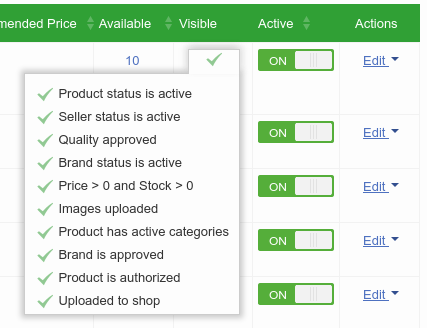
Quality control
One of the most important items of the validation for the product to be published in linio.com automatically, is the Quality control. This can be viewed when editing the product in Seller Center.
To be approved, the product must have a score equal to or greater than 75% .
You can learn more by clicking here.
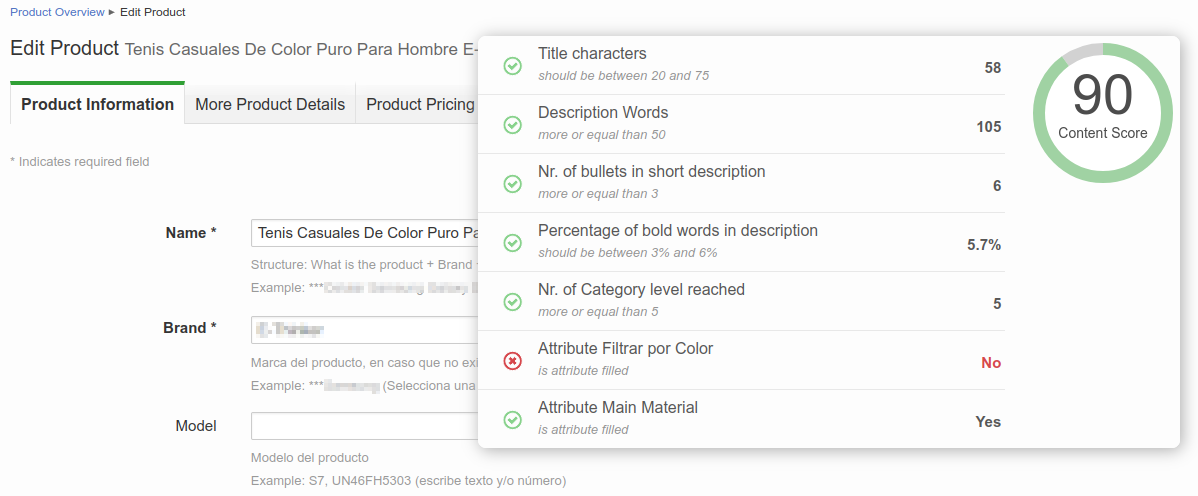
Update product
Updating the changes applied in your VTEX store to Seller Center is done automatically.
The only thing you should keep in mind is that only those products that have the Linio Sales Policy checked will be synchronized.
Security stock
The integration manages a security stock to avoid purchases of products without stock. Its default value is 5, which means that if a SKU has 5 or fewer units in stock, it will be deactivated in Seller Center.
This value can be modified from VTEX store, configuring a new attribute, the steps to follow are the next:
- Go to the main category and create a "combo" type SKU attribute with the name "LIN_SecurityStock" or "FALA_SecurityStock", depending on whether it is Linio or Falabella:
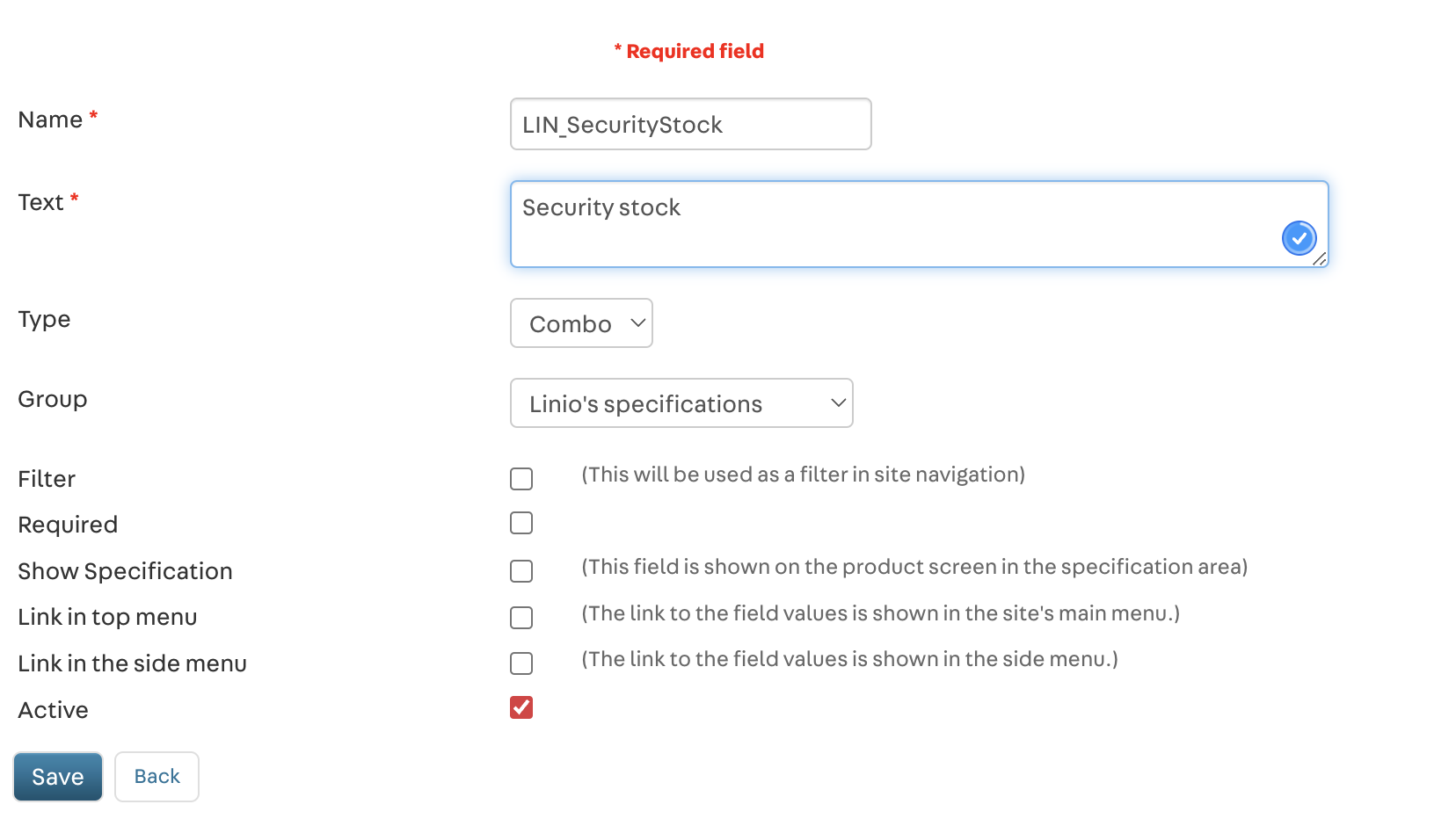
- Add the values you want to use:


- Complete attribute on the SKU that you want to modify security stock:
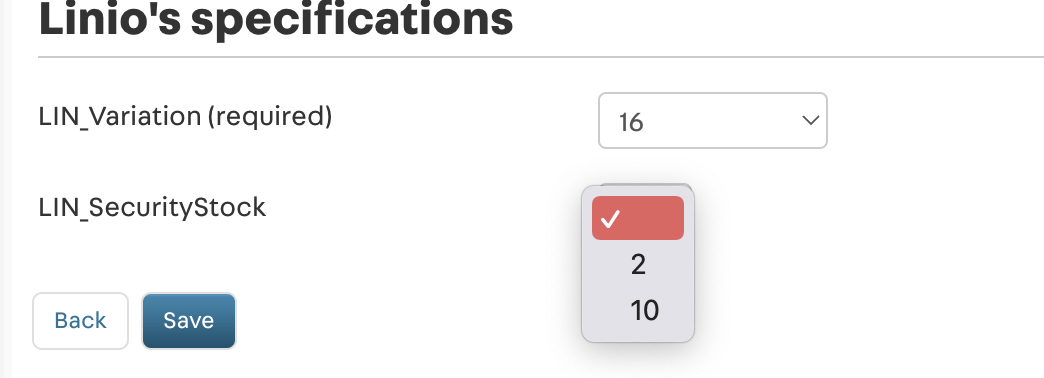
Unlimited stock VTEX
The integration doesn't allow products with unlimited stock configuration. If a product has this setting enabled, it will be created in Seller Center with stock 0 and inactive status.

Disable Product
To disable a product in linio.com of Seller Center, you must perform the following steps:
-
In your VTEX store
- Find the product that you don't want to sync.
- Uncheck the Linio Sales Policy.

-
In Seller Center
- Find the product to deactivate
- In the Active column, change the status of the switch from ON to OFF.

Offers
The integration supports offer prices per SKU, indicating it for each SKU in the sales policy created for Linio.
We must generate an offer price on the Linio sales policy created in the desired SKU
Edit SKU price for linio trade policy:
Menu > Catalog > Products and SKUs > Click on the price icon ($)


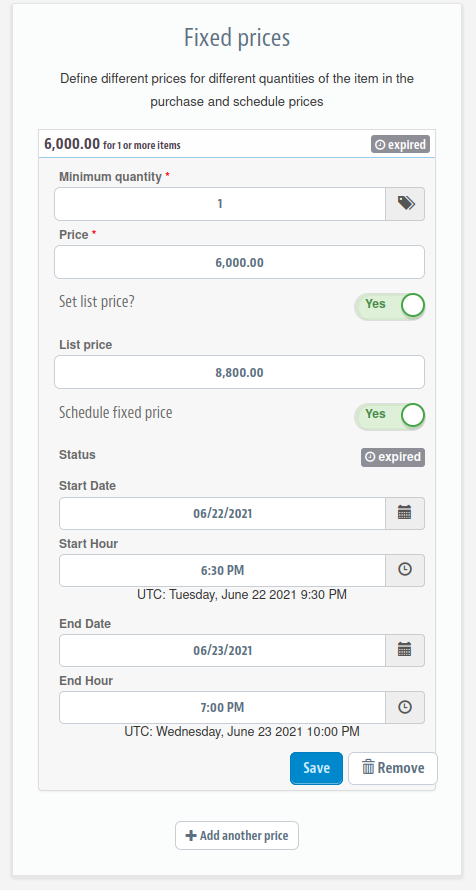
Seasonal promotions
Currently the integration does not support seasonal promotions, however we are working on adding this feature. We will have news soon.
Orders
Order synchronization
Orders generated in Seller Center are automatically synchronized in your VTEX store.
Workflows covered:
- Creation: Orders will be created in linio.com and this will be replicated in your VTEX store.
- Invoiced: The orders created in VTEX will be invoiced and will be updated in Seller Center to the status Ready to ship.
- Cancelled: Orders can be cancelled both from Seller Center and from VTEX, and the result will be replicated in its counterpart (keep in mind that it will only happen if the order in VTEX was not invoiced).
It's important to mention that every time that the state is changed, a note is added to the VTEX invoice indicating this. \ For the order to be synchronized from Seller Center to VTEX, the product must have stock in the VTEX store assigned to the sales policy and this must be checked .
Order document
When an order is synced with VTEX, the integration adds a note with the URLs of the generated documents.

Configuration suffix
This configuration adds the Seller Center order number to the identifier of the VTEX order.
The integration creates orders with an identifier consisting of {affiliate}-{Order ID Seller Center}, for example, "LNS-123123". When this option is enabled, the order will be created with an identifier consisting of {affiliate}-{Order ID Seller Center}-{Order number Seller Center}, for example, "LINIO-123123-22112211".
To activate this option, you need to ask the integrations support team to enable this setting.
Shipping
Sending orders
Order processing in Linio is different whether you use your own shipping agreement or those of Linio.
Statuses available for orders:
| Status | Description |
|---|---|
| Pending | It is the default status for new orders. |
| Cancelled | It is an optional status for orders. You should know that a cancellation fee will be charged in some cases (get more information at the end of the document). |
| Ready to Ship | It is the status to be dispatched. Important: The product should be packed in your warehouse and be ready to be picked up. After that, the status will change to "Shipped". |
Scenario 1: Using your own shipment agreement.
- A new order is received at your Seller Center account.
- If the SKU sold at Linio exists into VTEX the order should be synced:
- VTEX SKU = Seller Center SellerSku.
- Inside the order details you should see the Status dropdown.
- Select "Invoice Package".
- Fill the Shipping Provider and Tracking Number.
- Click the Save button.
As you will see, it is not possible to change the status to "Shipped" or "Delivered". This happens because even if you want to use your own shipment agreement, you must use a valid shipment provider available at Linio. You cannot feed a carrier which is not valid for Linio.
Offering different shipping options allows customers to choose the shipping cost and delivery time that best suits them. Each shipping method may be suitable for different groups of customer:
| Shipping method | Description |
|---|---|
| Postal | This is preferred by customers who opt for a low-cost or free shipping method and are willing to wait longer for the delivery of their products. |
| Express | This is preferred by customers willing to pay extra for quick delivery and may be more appropriate in certain circumstances (e.g. product bought as a gift, holiday season, etc). |
Scenario 2: Using Linio's shipment providers agreement.
To process an order please follow the same steps as in Scenario 1.
After you refresh the page, you will see the links to get documents on the order comments:
• Invoice: It is the receipt from Linio. Attach it into the package to be discovered by the customer once the package is delivered.
• Shipping Parcel: Is the PDF generated by Seller Center. Print and paste it on the package in order to send the product to the customer.
Scenario 3: Cancellations:
- The cancellation follows the first 4 steps from the Order dispatching, but instead of Invoice Package, the selection should be "Cancel order".
- Click on the Save button.
The order should be cancelled at Seller Center and in VTEX. As a result, the product becomes OFF in the Linio Store.
What happens in my store?
- Firstly, you must generate some necessary elements in order to meet the needs of the integration that will carry out the transactions to synchronize products and orders (sales policy, dock, postal code, add-on application installation, others).
- Once in Phase 02, specifications will be created at the product level and the SKU within a group specially identified for Linio. These specifications must be completed and these data will be replicated in Seller Center.
Do products sync automatically?
Yes, products are automatically synchronized from VTEX to Seller Center.
Do orders sync automatically?
Yes, orders are automatically synchronized from Seller Center to VTEX and vice versa depending on the status equivalence.
I have a staging store, can I validate the integration here?
Yes, Linio has a staging environment for testing. The only condition to take into account is that the VTEX-STG store must match Seller Center-STG and VTEX-PROD must match Seller Center-PROD.
Store in Staging or Production?The integration processes from staging and production environments are independent from each other. In other words, if you have the integration in your staging store and you want to move to production, you will have to repeat the process for the new environment, which will duplicate the work.
Take this into consideration when deciding in which environment to do the integration.
What data do I need to have to start the process?
To begin the integration process of VTEX with Seller Center you must have the following information:
In your Seller Center store:
Requirements | Description |
|---|---|
Seller Center account | It is essential to have an account enabled to sell on Linio.\ Needing one?. |
KAM | To begin the integration process it is essential to have assigned a KAM (Key Account Manager) |
In your VTEX store:
Requirements | Description |
|---|---|
Store | You must have a VTEX store enabled. |
Trade policy | We always recommend creating a trade policy, especially dedicated to our integration. Anyway, if you need it, you can use whichever you want. |
Postal code | This setting is important for the shipping process for your products. |
Proxy For Linio App | You must have the Proxy For Linio App installed in your store, this will be necessary to be able to synchronize the orders between Seller Center and VTEX. |
How do I start the process?
The first process should be started by contacting your KAM (Key Account Manager), who will contact the Integrations team, which will provide specific instructions to move forward with each one of the phases mentioned below.\ Do not start any phase without the integration team or your KAM instructing you to do so.
Phase status
Each one of the phases mentioned below has three basic status:
| Status | Description |
|---|---|
| Instructions | The integrations team sends the instructions and complementary information to be able to start each phase. |
| Validation | The data is received, processed, analyzed and validated to be right, otherwise the team helps you to achieve the expected result. |
| Approval | The approval of the phase is reported and instructions for the next one are indicated. |
Phase 01: Settings
The initial setting process is composed of the following items:
- Settings in the VTEX store.
- Initial settings for Seller Center.
- Confection of sellers.csv.
- Mapping brands and categories.
Settings in VTEX
You must make the following settings in your VTEX store. You can use the ones you have configured, but we always recommend isolating each of the integrations in your store as much as possible in order to prevent future inconveniences.
Trade Policy creation
We must create a commercial policy specially destined for our integration, this will determine which products should be synchronized with Seller Center. Official documentation.
Loading dock creation
We must create a dock. Official documentation.
Postal Code creation
Please see the following instructions to correctly create the postal code. Download
Proxy For Linio
We must install a complementary app in our store that is not available in the VTEX marketplace, so you must request it by generating a support ticket. You will then have the necessary information to do so.
- Enter VTEX support.
- Generate a new ticket with the following content, accompanied by the image below.
Greetings,
We are performing the integration process with linio.com, they told us that we need to request the installation of the following application in our store.
AccountName: {{Replace}}
Please let us know if you will require any additional information to execute the request.
Regards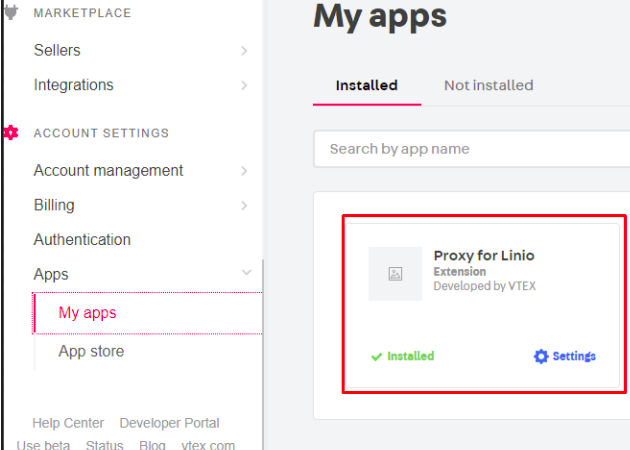
API credentials
We must create and set up credentials for the API: VTEX API credentials.
When assigning a user role, you can assign the role "owner" or, in case you create a new role or use another one, you must ensure it has at least the following permissions:
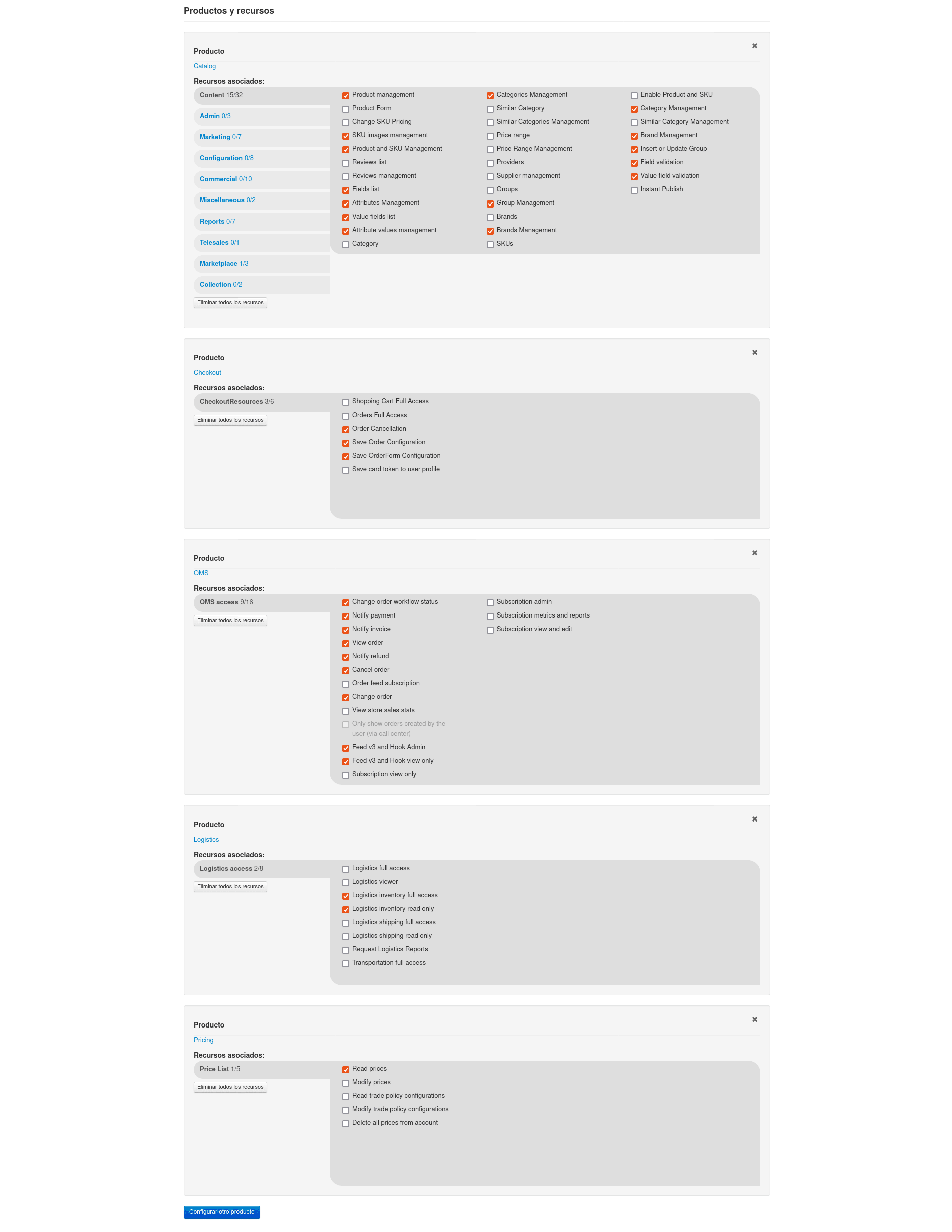
Seller Center settings
Create the sellers.csv file
With the settings previously made in your VTEX store, we will create a sellers.csv file with the data mentioned below.
store,name,sellercenter_key,sellercenter_secret,vtex_seller_id,trade_policy_id,has_automatic_guide,dock_id,identifier,vtex_api_key,vtex_api_secret
MX,MyLinioStore,[email protected],testL1Ni05e11eRcen7erC0nV7ex,1,7,1,1s2bc,MyVtexStore,vtexappkey-example-SDFMMM,OYGHBEUGOMTBHJTHVYEDQKJRQIFZGGMCJJJJJGOODVUFTSDVKSQUMRVEPDetail of the fields\ Seller Center
Field | Type | Description |
|---|---|---|
store | Chile: CL | It is the country code where you registered your store |
name | Text | It is your Seller Center account's name. |
has_automatic_guide | Number
| Indicate if you will work with automatic shipping guides provided by Linio Shipping Provides. |
sellercenter_key | This is the user that you have configured in your Seller Center store with Full Access permissions | |
sellercenter_secret | Text | Your API-KEY at Seller Center. |
Fields | Type | Description |
|---|---|---|
vtex_seller_id | Number | It is your Seller VTEX ID. You can check it from |
trade_policy_id | Number | It is the trade policy ID generated for your Linio integration. You can check or create this from: |
dock_id | Alphanumeric | It is the dock that you, as a seller, have set for Linio. You can check or create this from: |
identifier | myStore.myvtex.com | It is your VTEX store name. |
vtex_api_key | vtexappkey-example-LNLVTEX | It is the VTEX API key. |
vtex_api_secret | Alphanumeric | It is the VTEX API secret. |
Attach and send the file sellers.csv in the email chain started by your KAM with the integrations team. The data will be validated and the necessary information will be sent to continue configuring the relationships between Brands and Categories in the Seller Center and your VTEX store.
Brands mapping (brands.csv)
You will receive a brands.csv file, where we must match the ID of the brand in your VTEX store with its equivalent in Seller Center.
You can review the following documentation: faqs > Brands, or you can clarify any concerns with your KAM (Key Account Manager).
Categories mapping (categories.csv)
You will receive a categories.csv file, where we must match the ID of the category in your VTEX store with its equivalent in Seller Center.
At this point we request that the level of the Seller Center category be the maximum available, which will vary between 4 and 5. In this way, we ensure that the products have a greater probability of approval by the Quality Control team.Example: * Fashion> Men (Level 2). * Fashion > Men > Men's Clothing > Men's T-shirts > Men's Short Sleeve T-shirts (Level 5)\
You can review the following documentation faqs > Categories or your can clear any concerns with your KAM (Key Account Manager).
Send brands.csv and categories.csv files
Attach and send the brands.csv and categories.csv mapping files in the email chain started by your KAM with the integrations team. The data will be validated to be correct to advance to the next phase or correct if its necessary.
Webhook configuration
Once these steps have been completed, you will be sent the data to configure the webhook in Seller Center. It will be used to establish the communication from VTEX to LINIO.
- Log in to your Seller Center account.
- Go to Integration Management.
- Settings > Integration Management > Webhooks and click Add webhook.
- Enter the URL provided and check all boxes (Feed, Order, Product).
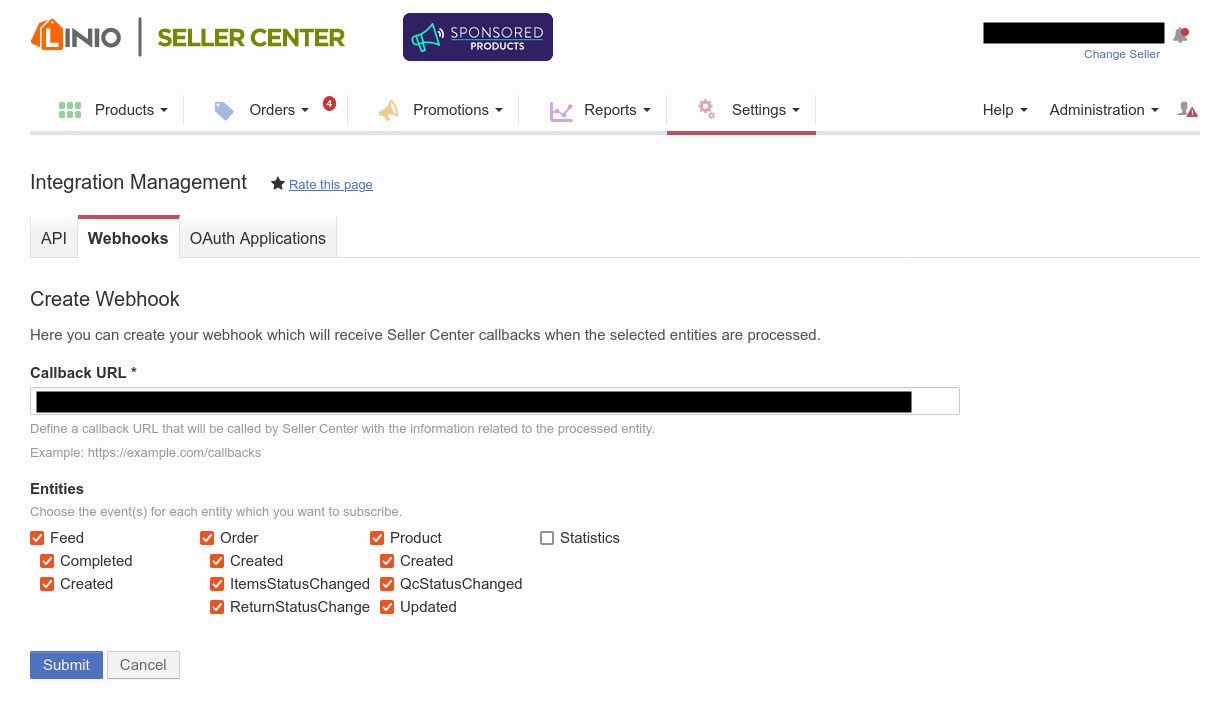
Configuring affiliate in VTEX
The URL to configure the affiliate in VTEX will be sent, it is used to establish communication from VTEX to Seller Center.
Follow the next steps:
- In your VTEX store, go to:
- Orders > Orders management > Settings > Affiliates > New affiliate
- Fill the fields as shown in the image below.
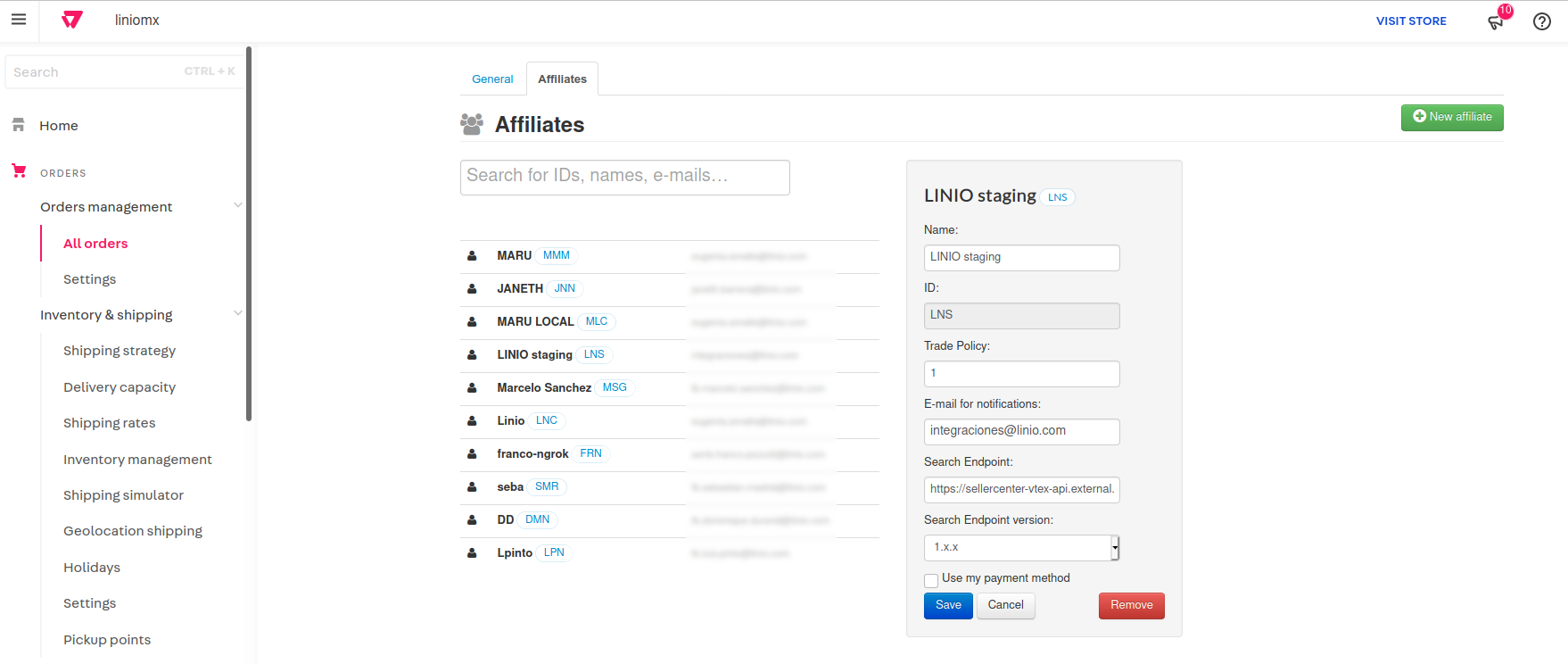
Phase 02: Catalog
Consist in generate a demo product in the VTEX store and performing a synchronization simulation with Seller Center.
This product that we will create has test written in various fields to prevent accidental purchase by users who are visiting linio.com, particularly in production environments.Demo product creation
The product that we will create in the VTEX store must meet the next conditions:
Condition | Description |
|---|---|
Trade Policy | The trade policy generated previously for the integration of Linio must be checked.\ * This determines if the product syncs with Seller Center . |
Category | It must be on the category mapped during the Phase 01: Initial Configuration. |
Image | It must have an image greater than 200x200 and smaller than 2000x2000 (see example image). |
Price | You must assign a price to the SKU for Linio's sales policy.\ We recommend it to be in accordance with the assigned category.\ If the price has more than 2 decimal digits it will be rounded up to 2 digits in SC. |
Stock | You must assign a stock to the SKU for Linio's sales policy.\ We recommend a value of 10, later used in Phase 03. |
Specifications | Complete all the specifications fields at Product and SKU level which are indicated with the label (Required). |
Example of demo product
- 00_img_demo.png: Image for the product.
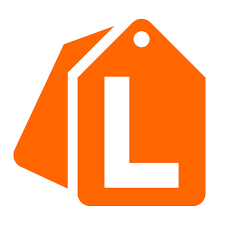
- 01_product_demo.png: Demo product list.

- 02_edit_product_product.png: Product data.

- 03_edit_product_specifications.png: Product specification data to be completed (LIN).
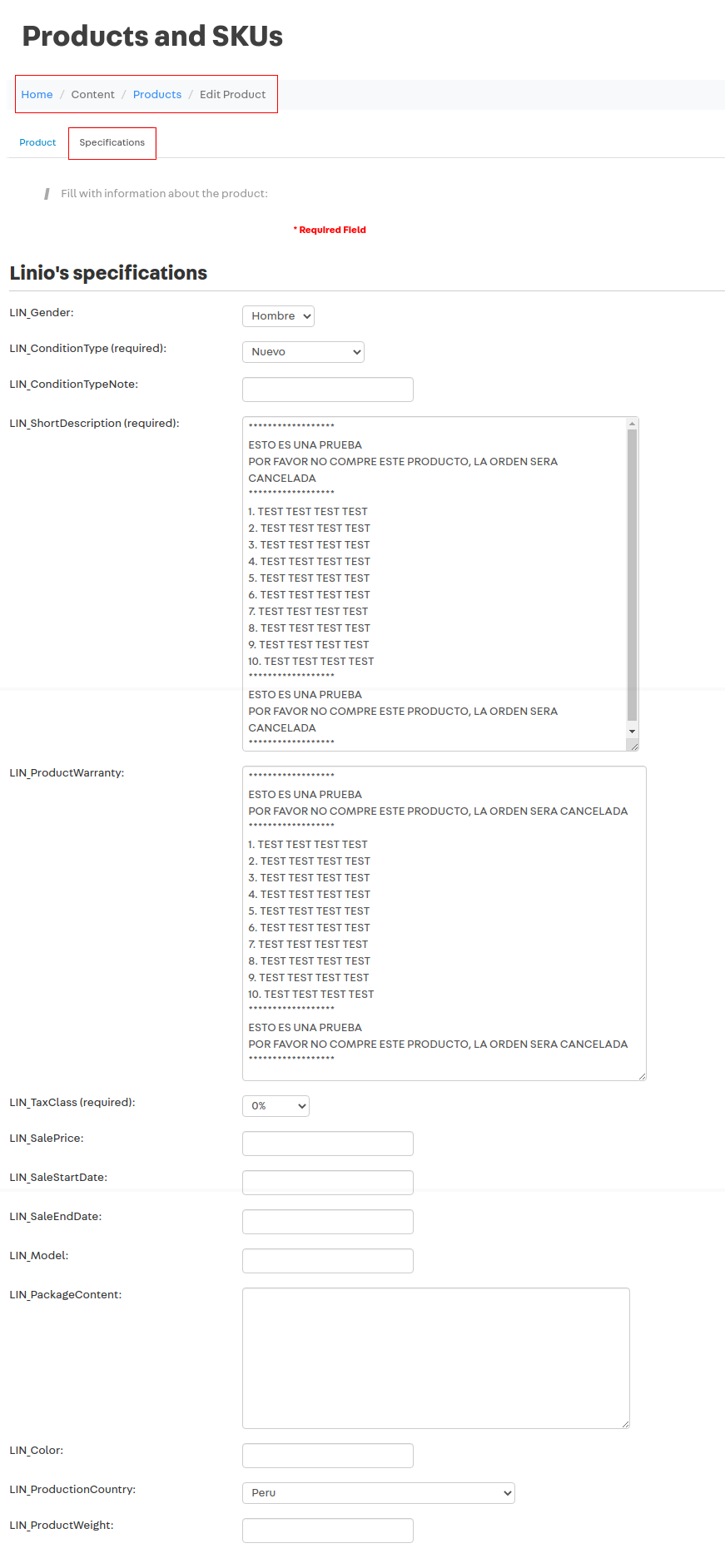
- 04_edit_sku_sku.png: Data of the SKU to complete
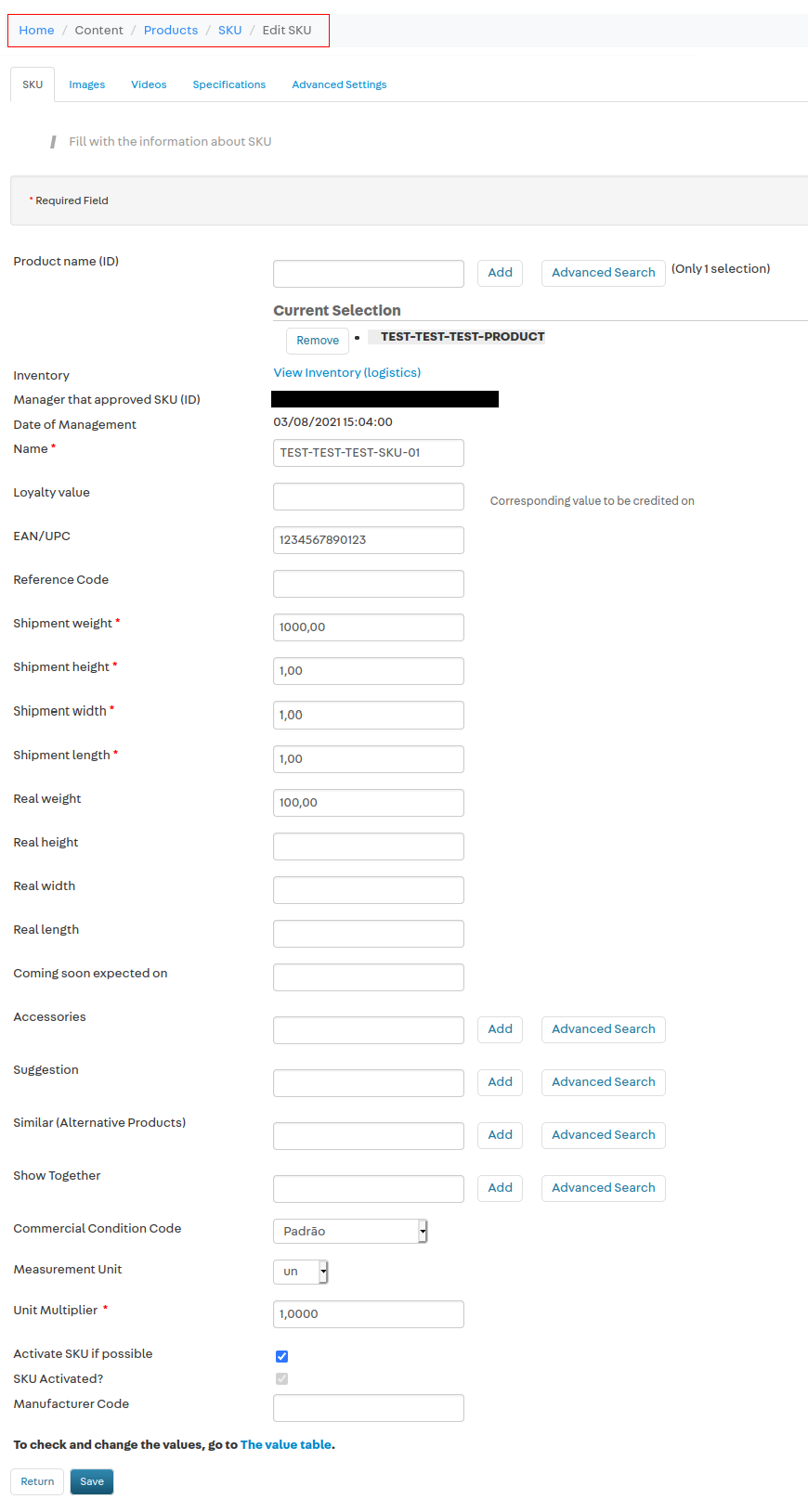
- 05_price_for_sku.png: Set price for Linio sales policy.

- 06_stock_for_sku.png: Set stock for Linio sales policy.
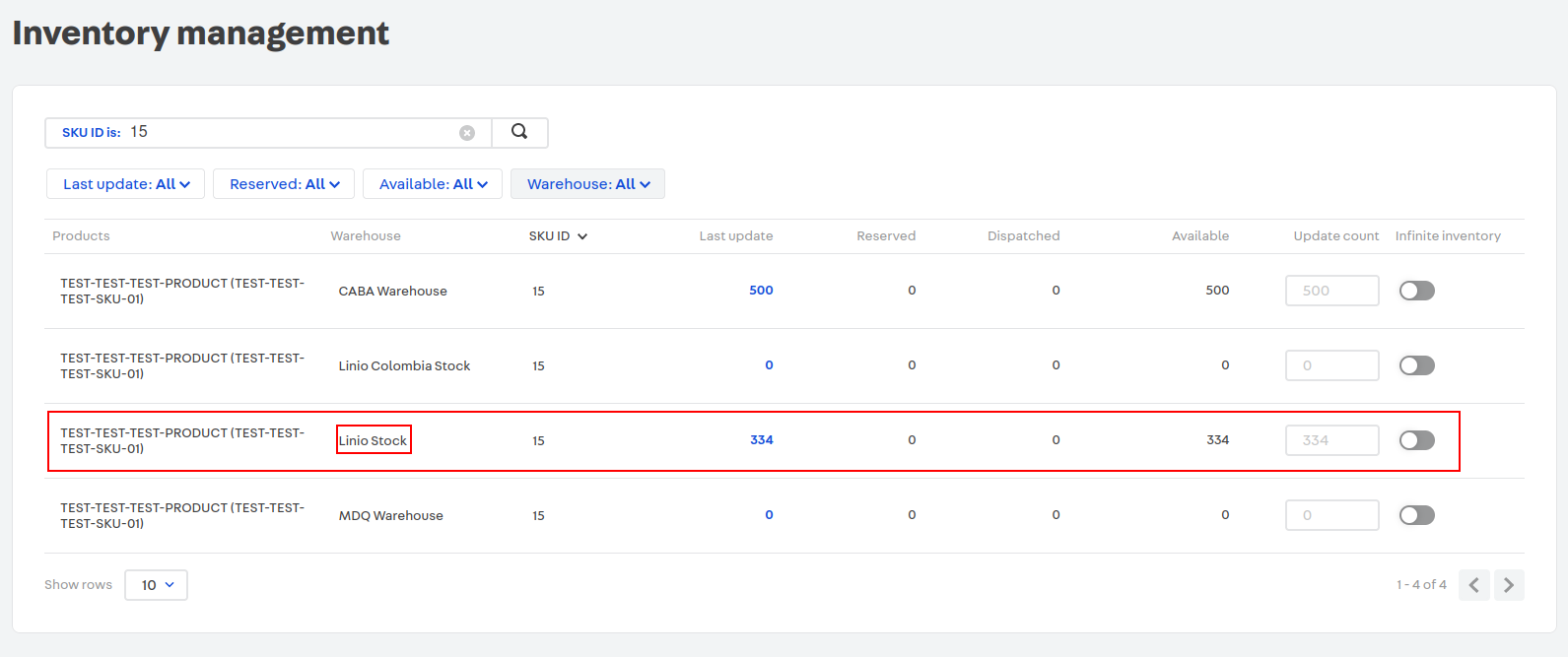
Submitting product data
Once the product has been generated, the following data must be sent in the same email chain:
- productId: 123456
- skuId: 654321
The Linio team will simulate the synchronization of the product, validating its correct operation.
If this test is successful, you will advance to Phase 03. Otherwise, the details to be corrected will be mentioned.
Phase 03: Orders
This phase is designed to validate the entire order flow from Seller Center to VTEX using a small test matrix.
Here we will count with the collaboration of your KAM (Key Account Manager) to advance with the previously generated product.
Taking the previously created demo product as an example.
| Demo product in | URL |
|---|---|
| Back End Url | https://{{URL-SC}}/product/edit/index/id/{{productID}} |
| Front End Url | https://{{URL-FrontShop}}/p/{{URL}} |
Order matrix
We complete the following order test matrix
Cases | Step 01 | Step 02 | Step 03 | Result |
|---|---|---|---|---|
| Case 1: Order Delivered | linio.com: Create a demo product order in linio Front End Url (1) | VTEX: Change the order status to Invoiced. | Seller Center:Change the order status to Delivered. (2) | Order status in |
| Case 2: Order Canceled in VTEX (3) | linio.com: Create a demo product order in linio Front End Url (1) | VTEX: | Not available | Order status in |
| Case 3: Order Canceled in Seller Center (3) | linio.com: Create a demo product order in linio Front End Url (1) | Seller Center: Change the order status to Canceled. | Not available | Order status in |
In case you detect any inconvenience that prevents further progress, please report it in the same email chain, otherwise continue until the matrix is finished and report the order numbers generated in Seller Center so that our team can validate the complete flow of orders.
- Case 1: Order number at Seller Senter: 0000001
- Case 2: Order number at Seller Senter: 0000002
- Case 3: Order number at Seller Senter: 0000003
(1) KAM will inform to the Logistics / Finance team that these orders are part of a demo.
(2) Status change requested by KAM to the logistics team.
(3) These cases must be cancelled, WITHOUT having changed the status in VTEX to invoiced.
Once the order matrix has been completed, you will be instructed to proceed to the final phase.
Phase 04: Full catalog synchronization
From this moment on, you can start synchronizing all the products you have in your VTEX store with Seller Center.
To accompany you with the aforementioned task or to clear up any doubts that may arise, we recommend consulting your KAM (Key Account Manager) as a strategic ally for success.
Further help
Your best ally
Your best ally, who can guide you at all times and who knows exactly which team to lean on, is your KAM (Key Account Manager).
Seller Center
If you have any questions about the internal processes carried out by Seller Center, for example, orders, shipments, deactivation of products, warranties, commissions, among others; please do not hesitate to consult our documentation by clicking here.
Integrations FAQs
You can visit a section with frequently asked questions which is constantly evolving, by clicking here.
Discuss
It has a section available where you can raise your concerns or even find the answers to those you have. Use the tags to quickly filter what you are looking for. Click here.
Contact us
In case you have any specific problem with the integration, you can contact us by the following means. Click here.
